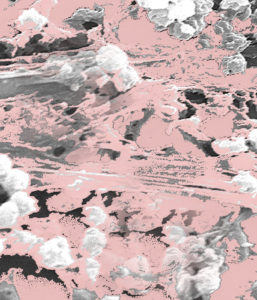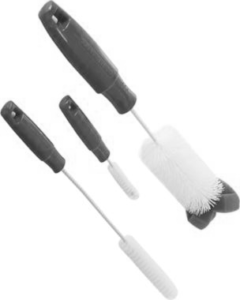Is Your Cat Water Fountain Slimy?
The technical term for that slime you find in your fountain is biofilm.
 And if you are finding slime in your cat fountain you almost certainly have a plastic cat fountain. The slime comes from your pets’ mouth and tongue which contain bacteria that adhere to the surfaces of vessels they drink and eat from. It may also be airborne, lands in the fountain water and thrives. Thorough cleaning with hot, soapy water will get rid of this biofilm at first but with use plastic fountains become scratched – no matter how careful you are – and cleaning the bacteria from those scratches is in fact, not possible. Unless you use bleach or some other powerful chemical agent, regularly, and scrub thoroughly, the bacteria will build up, creating an unhealthy environment that can cause a number of ailments for your pet and you.
And if you are finding slime in your cat fountain you almost certainly have a plastic cat fountain. The slime comes from your pets’ mouth and tongue which contain bacteria that adhere to the surfaces of vessels they drink and eat from. It may also be airborne, lands in the fountain water and thrives. Thorough cleaning with hot, soapy water will get rid of this biofilm at first but with use plastic fountains become scratched – no matter how careful you are – and cleaning the bacteria from those scratches is in fact, not possible. Unless you use bleach or some other powerful chemical agent, regularly, and scrub thoroughly, the bacteria will build up, creating an unhealthy environment that can cause a number of ailments for your pet and you.
Germs
Chin acne on your pet is a commonly reported consequence of this bacterial buildup. A recent study conducted by the National Sanitation Foundation (NSF) concluded that pet bowls are the fourth leading source for places in the home that contain the most germs. Several manufacturers include cleaning equipment with their fountains but unless these are used scrupulously and assiduously, they will not be adequate. Further, plastic contains a chemical called BPA which is a known carcinogenic and can cause and has caused cancer. Even those plastic products which claim to be BPA-free can be just as dangerous by having replaced the BPA with an equally as toxic substance. It is a practice known as “regrettable substitution”.

Can slime be prevented or eliminated from plastic pet fountains?
To a degree. There are a few things you can do to eliminate and prevent the build-up of biofilm and that involves cleaning. You must regularly clean your plastic pet fountain with bleach or some similar chemical and tools such as these, then rinse very thoroughly. (Your cat won’t go near the fountain if it has even a touch of bleach smell to it). Unfortunately, the real and best answer is, don’t use plastic pet fountains. Yes, you paid good money for them and oh yes, your pets may love their plastic fountain but they won’t associate their pain and discomfort with their drinking source. Which is why we must. It is a simple and unavoidable truth that plastic is not the material pet’s fountains should be made of.
Below are reviews on Amazon of one of the leading brands of plastic pet fountains.
“While the unit continues to operate flawlessly, I notice the water is very slimy when I clean it. It only takes the water a couple of days to get like this. No one in the online forums seems to know how to get rid of this. I called (redacted company name) and they advised running vinegar through the fountain which I did for several hours. Tried again this week, the cat won’t go near it, and the water is slimy again. I tap out.”
“If you like cleaning slime every week this is for you.
We bought this and the cats loved it, the problem is that it builds up a bacterial slime on every part and it has to be taken apart and washed every week. This is a half hour process leaning over the tub, trying to clean the motor out with the little brushes that are sold for it. We have tried multiple times to run it through the dishwasher but it does not clean all of the scum off this as it can not go onto the hottest setting which is the only thing that would work but that would melt or cause the plastic to get brittle.
Now this sits in a corner of the bathroom, it has not been run in over 6 months and I am considering putting it out at the next yard sale!”
So all those ads you see for ‘the best cat fountain’ and ‘the best pet fountains’ and ‘the ten best water fountains…’ which feature plastic fountains are bogus and underwritten by the manufacturers themselves. These fountains are, in fact, the worst possible choice and you need to know this. It isn’t a matter of opinion. It is a matter of fact. There is more than one brand of truly high-quality pet fountains out there but it is important to know which ones are definitely not.The best choice
The number 1 choice of veterinarians for pets water bowls and fountains is ceramic. The reason for this is that ceramic is not porous and it doesn’t get scratched. But here again it is necessary to be vigilant. Most ceramic pet fountains are made in countries which do not regulate the use of harmful minerals (lead, cadmium cobalt, etc.) in ceramics and you don’t know if those materials have been used in the ceramic pet fountains they make. Only if the maker of the fountains make the glazes themselves and certifies that no harmful minerals are used can you be sure. Your best bet then is to buy ceramic pet fountains from reputable fountain creators in the United States who make their own glazes and know what is in them. There are not many of them and so far as we know (and many customers state in their reviews) ThirstyCats at www.thirstycatfountains.com created the best and most beautiful worldwide.
Or use the coupon code – best choice – for 10% off non-sale items in our shop.
